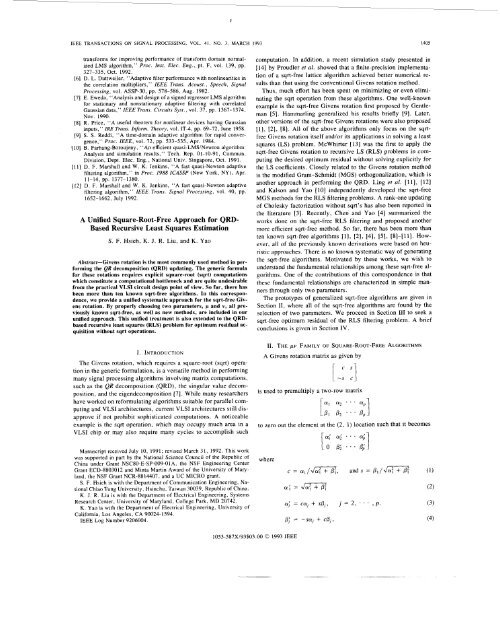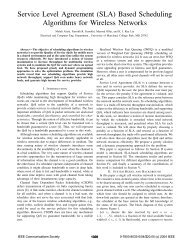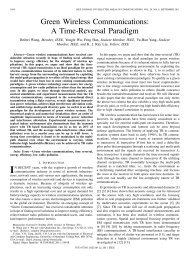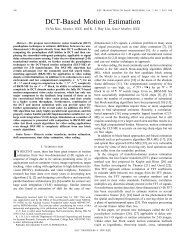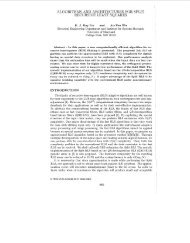A unified square-root-free approach for QRD-based recursive-least ...
A unified square-root-free approach for QRD-based recursive-least ...
A unified square-root-free approach for QRD-based recursive-least ...
You also want an ePaper? Increase the reach of your titles
YUMPU automatically turns print PDFs into web optimized ePapers that Google loves.
IEEE TRANSACTIONS ON SIGNAL PROCESSING. VOL. 41. NO. 3. MARCH 1993 1405<br />
trans<strong>for</strong>ms <strong>for</strong> improving per<strong>for</strong>mance of trans<strong>for</strong>m domain normalized<br />
LMS algorithm,” Proc. Inst. Elec. Eng., pt. F, vol. 139, pp.<br />
327-335, Oct. 1992.<br />
[6] D. L. Duttweiler, “Adaptive filter per<strong>for</strong>mance with nonlinearities in<br />
the correlation multipliers,” IEEE Trans. Acoust. , Speech, Signal<br />
Processing, vol. ASSP-30, pp. 578-586, Aug. 1982.<br />
[7] E. Eweda, “Analysis and design of a signed regressor LMS algorithm<br />
<strong>for</strong> stationary and nonstationary adaptive filtering with correlated<br />
Gaussian data,” IEEE Trans. Circuits Syst., vol. 37, pp. 1367-1374,<br />
Nov. 1990.<br />
[8] R. Price, “A useful theorem <strong>for</strong> nonlinear devices having Gaussian<br />
inputs,” IRE Trans. Infarm. Theory, vol. IT-4, pp. 69-72, June 1958.<br />
[9] S. S. Reddi, “A time-domain adaptive algorithm <strong>for</strong> rapid convergence,”<br />
Proc. IEEE, vol. 72, pp. 533-535, Apr. 1984.<br />
[lo] B. Farhang-Boroujeny, “An efficient quasi-LMSiNewton algorithm:<br />
Analysis and simulation results,’’ Tech. Rep. 01-10-91, Commun.<br />
Division, Dept. Elec. Eng., National Univ. Singapore, Oct. 1991.<br />
1111 D. F. Marshall and W. K. Jenkins, “A fast quasi-Newton adaptive<br />
filtering algorithm,” in Proc. 1988 ICASSP (New York, NY), Apr.<br />
11-14, pp. 1377-1380.<br />
[I21 D. F. Marshall and W. K. Jenkins, “A fast quasi-Newton adaptive<br />
filtering algorithm,” IEEE Trans. Signal Processing, vol. 40, pp.<br />
1652-1662, July 1992.<br />
A Unified Square-Root-Free Approach <strong>for</strong> <strong>QRD</strong>-<br />
Based Recursive Least Squares Estimation<br />
S. F. Hsieh, K. J. R. Liu, and K. Yao<br />
Abstract-Givens rotation is the most commonly used method in per<strong>for</strong>ming<br />
the QR decomposition (<strong>QRD</strong>) updating. The generic <strong>for</strong>mula<br />
<strong>for</strong> these rotations requires explicit <strong>square</strong>-<strong>root</strong> (sqrt) computations<br />
which constitute a computational bottleneck and are quite undesirable<br />
from the practical VLSI circuit design point of view. So far, there has<br />
been more than ten known sqrt-<strong>free</strong> algorithms. In this correspondence,<br />
we provide a <strong>unified</strong> systematic <strong>approach</strong> <strong>for</strong> the sqrt-<strong>free</strong> Givens<br />
rotation. By properly choosing two parameters, p and v, all previously<br />
known sqrt-<strong>free</strong>, as well as new methods, are included in our<br />
<strong>unified</strong> <strong>approach</strong>. This <strong>unified</strong> treatment is also extended to the <strong>QRD</strong><strong>based</strong><br />
<strong>recursive</strong> <strong>least</strong> <strong>square</strong>s (RLS) problem <strong>for</strong> optimum residual acquisition<br />
without sqrt operations.<br />
I. INTRODUCTION<br />
The Givens rotation, which requires a <strong>square</strong>-<strong>root</strong> (sqrt) operation<br />
in the generic <strong>for</strong>mulation, is a versatile method in per<strong>for</strong>ming<br />
many signal processing algorithms involving matrix computations,<br />
such as the QR decomposition (<strong>QRD</strong>), the singular value decomposition,<br />
and the eigendecomposition [7]. While many researchers<br />
have worked on re<strong>for</strong>mulating algorithms suitable <strong>for</strong> parallel computing<br />
and VLSI architectures, current VLSI architectures still disapprove<br />
if not prohibit sophisticated computations. A noticeable<br />
example is the sqrt operation, which may occupy much area in a<br />
VLSI chip or may also require many cycles to accomplish such<br />
computation. In addition, a recent simulation study presented in<br />
[ 141 by Proudler et al. showed that a finite-precision implementation<br />
of a sqrt-<strong>free</strong> lattice algorithm achieved better numerical results<br />
than that using the conventional Givens rotation method.<br />
Thus, much ef<strong>for</strong>t has been spent on minimizing or everl eliminating<br />
the sqrt operation from these algorithms. One well-known<br />
example is the sqrt-<strong>free</strong> Givens rotation first proposed by Gentleman<br />
[5]. Hammarling generalized his results briefly [9]. Later,<br />
other versions of the sqrt-<strong>free</strong> Givens rotations were also proposed<br />
[l], [2], [8]. All of the above algorithms only focus on the sqrt<strong>free</strong><br />
Givens rotation itself andlor its applications in solving a <strong>least</strong><br />
<strong>square</strong>s (LS) problem. McWhirter (131 was the first to apply the<br />
sqrt-<strong>free</strong> Givens rotation to <strong>recursive</strong> LS (RLS) problems in computing<br />
the desired optimum residual without solving explicitly <strong>for</strong><br />
the LS coefficients. Closely related to the Givens rotation method<br />
is the modified Gram-Schmidt (MGS) orthogonalization, which is<br />
another <strong>approach</strong> in per<strong>for</strong>ming the <strong>QRD</strong>. Ling et al. [ll], 1121<br />
and Kalson and Yao [lo] independently developed the sqrt-<strong>free</strong><br />
MGS methods <strong>for</strong> the RLS filtering problems. A rank-one updating<br />
of Cholesky factorization without sqrt’s has also been reported in<br />
the literature 131. Recently, Chen and Yao [4] summarized the<br />
works done on the sqrt-<strong>free</strong> RLS filtering and proposed another<br />
more efficient sqrt-<strong>free</strong> method. So far, there has been more than<br />
ten known sqrt-<strong>free</strong> algorithms 111, [2], [4], 151, [8]-[ll]. However,<br />
all of the previously known derivations were <strong>based</strong> on heuristic<br />
<strong>approach</strong>es. There is no known systematic way of generating<br />
the sqrt-<strong>free</strong> algorithms. Motivated by these works, we wish to<br />
understand the fundamental relationships among these sqrt-<strong>free</strong> algorithms.<br />
One of the contributions of this correspondence is that<br />
these fundamental relationships are characterized in simple manners<br />
through only two parameters.<br />
The prototypes of generalized sqrt-<strong>free</strong> algorithms are given in<br />
Section 11, where all of the sqrt-<strong>free</strong> algorithms are found by the<br />
selection of two parameters. We proceed in Section I11 to seek a<br />
sqrt-<strong>free</strong> optimum residual of the RLS filtering problem. A brief<br />
conclusions is given in Section IV.<br />
11. THE pv FAMILY OF SQUARE-ROOT-FREE ALGORITHMS<br />
A Givens rotation matrix as given by<br />
is used to premultiply a two-row matrix<br />
CY1<br />
CY2...ap<br />
PI 02 - . . 0,<br />
to zero out the element at the (2, I) location such that it becomes<br />
a; ff; . . . ff;<br />
1<br />
Manuscript received July 10, 1991; revised March 31, 1992. This work<br />
was supported in pan by the National Science Council of the Republic of<br />
China under Grant NSC80-E-SP-009-01 A, the NSF Engineering Center<br />
Grant ECD-8803012 and Minta Martin Award of the University of Maryland,<br />
the NSF Grant NCR-8814407, and a UC MICRO grant.<br />
S. F. Hsieh is with the Department of Communication Engineering, National<br />
Chiao Tung University, Hsinchu, Taiwan 30039, Republic of China.<br />
K. J. R. Liu is with the Department of Electrical Engineering, Systems<br />
Research Center, University of Maryland, College Park, MD 20742.<br />
K. Yao is with the Department of Electrical Engineering, University of<br />
Cali<strong>for</strong>nia, Los Angeles, CA 90024- 1594.<br />
IEEE Log Number 9206004.<br />
where<br />
c = a,/-, ands = PI/- (1)<br />
1053-587X/93$03.00 0 1993 IEEE
I<br />
I406 IEEE rRANSACTIONS ON SIGNAL PROCESSING, VOL. 41, NO. 3. MARCH 1993<br />
In VLSI circuit design, sqrt operation is expensive, because it<br />
takes up much area or is slow (due to many iterations). There<strong>for</strong>e,<br />
it is advantageous to avoid or minimize sqrt operations.<br />
By taking out a scaling factor from each row, the two rows under<br />
consideration be<strong>for</strong>e and after the Givens orthogonal trans<strong>for</strong>mations<br />
is denoted by<br />
and<br />
where<br />
,, kh, k6, and kA are the scaling factors resulting in sqrt-<strong>free</strong> - .<br />
operations, and a: and p: are the updated a, and 0, when PI is<br />
zeroed out.<br />
Now, our task is to find the expressions <strong>for</strong>, k:, ki, a;, {(a,’,<br />
b,’), j = 2. . . . , p}, in terms of k,, kh, {(a,, bl),j = 1, . . . ,p},<br />
such that no sqrt operation is actually needed. The sqrt expressions<br />
and 4 in (5) and (6) are used <strong>for</strong> representa-<br />
of a, a, 4.<br />
tional purposes only and are not actually per<strong>for</strong>med.<br />
Replacing a, = &a,, 0, = a b,, ai = &U,’, 6; = &b,’, j<br />
= 1, . . . , p, in (1)-(4) leads to<br />
(6)<br />
s expressions in (18) are not explicitly needed in the computation<br />
of (l3)-(17). The use of the rotation parameter c in (18) (with one<br />
sqrt operation) will be further considered in Section I11 when the<br />
optimum residual e is desired. Furthermore, Section 111 will show<br />
that it is possible to obtain e without any sqrt operation and the<br />
explicit computation of the rotation parameter c can be bypassed.<br />
To avoid repetitive computations and take the advantage of previously<br />
computed results, (14). (16), and (18) use the newly updated<br />
k: of (13). As stated earlier, we are <strong>free</strong> to choose those two parameters<br />
p and U. Different choices of p and U will affect the number<br />
of multiplications and divisions, as well as the numerical stability<br />
and parallelism of these computations.<br />
It can be easily shown that this <strong>unified</strong> view can generate all of<br />
the previously known sqrt-<strong>free</strong> algorithms via a proper choice of p<br />
and U. In fact, there has been more than ten sqrt-<strong>free</strong> algorithms<br />
known so far. Among them are Gentleman [5], Hammarling [9],<br />
Bareiss [I], Kalson and Yao [IO], Ling er al. [Ill, [12], Barlow<br />
and Ispen [2], Chen and Yao 141, Gotze and Schwiegelsohn [8].<br />
For example, if we choose p = 1 and U = 1, it becomes the sqrt<strong>free</strong><br />
algorithm proposed by Gentleman in [5] and can be updated<br />
as follows:<br />
k6 = k,,a: + k,bt (19)<br />
ki, = k,,ki,/kA (20)<br />
a; = 1 (21)<br />
a; = J(k,at + kbbt)/kL<br />
a,’ = (k,a,a, +khb1b,)/kl,<br />
b,’ = -bla, + a,b,.<br />
j = 2, . . . . P<br />
1<br />
a; = [koala, + kbblb,] j = 2, . . . 3 P. To check that these results are correct, we find that<br />
4 Jk,a: + kbb:<br />
To avoid sqrt computation, we need to determine k: and ki such<br />
that ai, a,’, and b,’ will not require sqrt operation. It is clear that if<br />
we choose k,!, and ki as<br />
and<br />
a; = 4 a ; =<br />
-<br />
kuala]<br />
+ khblb,<br />
4<br />
ala, + PIP,<br />
= c,a/ + SIP]<br />
m<br />
(22)<br />
ku kb<br />
k’ - v2(k,a: + kbb:) .IO, - Pia, -<br />
- - -sa, + cp,<br />
(24)<br />
where p and U are parameters that will be determined later to be<br />
any sqrt-<strong>free</strong> function of k,, kb, a,, and b,, then @-(IO) can be<br />
which are consistent with the results in (3) and (4). For the systolic<br />
computed without sqrt operation. We then have the following uparray<br />
implementation described in [13], we choose a, = 1 and dedating<br />
<strong>for</strong>mulas without sqrt operation:<br />
fine the generalized rotational parameters<br />
k: = (koa: + kbb:)/p2 (13)<br />
Then we have<br />
C = k,/k‘:, and S = k,b,/k,!,. (25)<br />
a,’ = Cu, + Sb,<br />
b,’ = b, - bla,.<br />
(27)<br />
(28)<br />
b,’ = u[-b,a, + a,b,] (17)<br />
c = (al/p)a, and s = (b,/p)Jkh/k:,. (18)<br />
Notice that the sqrt operations disappear in our <strong>for</strong>mulas of (13)-<br />
(17), while they are needed in the Givens rotations. Also, the c and<br />
These results are consistent with the works by Gentleman [5] and<br />
McWhirter [ 131. The details of the systolic implementation can be<br />
found in [13].<br />
In Table I, we list various sqrt-<strong>free</strong> algorithms and the corresponding<br />
choices of p and U. Hence, this class of sqrt-<strong>free</strong> algo-
IEEE TRANSACTIONS ON SIGNAL PROCESSING, VOL. 41, NO. 3, MARCH 1993<br />
I407<br />
TABLE I<br />
SOME KNOWN SQRT-FREE ALGORITHMS OF THE pv FAMILY<br />
Ir V Authors (Year) Remark<br />
1<br />
Gentleman (1973) a, = 1<br />
Hammarling (1974)<br />
1<br />
a, + k,b:<br />
Bareiss (1982)<br />
Ling (1989), KalsoniYao (1985) k,,a, = 1<br />
CheniYao (1988) k,a, = 1<br />
1<br />
GotzeiSchwiegelshohn (1989)<br />
BarlowiIspen (1 987)<br />
Scaled<br />
New algorithm<br />
~-<br />
TABLE I1<br />
COMPARISONS OF COMPUTATIONAL COMPLEXITY OF SOME MEMBERS IN +V FAMILY<br />
Multiplication Division Addition<br />
Square Root<br />
Givens Rotation<br />
4P<br />
1 2p - 1 1<br />
p = l , u = l 4p + 3 1 2p - 1 0<br />
2p + 6 2 2p - 1 0<br />
2p + 6 2 2p - 1 0<br />
1<br />
p = l , v = -<br />
a,<br />
4p + 4 2 2p - 1 0<br />
4p + 5 1 2p - 2 0<br />
Cc=-<br />
koa: + khb: , u = 1 4p + 6 2 2p - 1 0<br />
ko kh<br />
1<br />
p = koa: + k,b:, v =<br />
koa: + khb:<br />
4p + 4 1 2p - 1 0<br />
rithms is called the pv family of sqrt-<strong>free</strong> Givens rotation algo- 1<br />
rithms.<br />
v =<br />
koa: + kbb:<br />
not Only can we generate those known sqrt-<strong>free</strong> algothen<br />
we can readily verify that this is a new sqrt-<strong>free</strong> algorithm. In<br />
flthms, but we are to find new sqrt-<strong>free</strong><br />
by fact, the new sqfl-<strong>free</strong> algorithm is among the best in the list of<br />
choosing new pairs Of (p, ’) parameters. an let us<br />
Table I in terms of number of divisions, e.g., it only requires one<br />
choose<br />
division and no <strong>square</strong> <strong>root</strong>. In principle, there are unlimited choices<br />
of p and v <strong>for</strong> sqrt-<strong>free</strong> algorithms. Table I1 shows comparisons of<br />
p = koa: + kbb:<br />
computational complexity of some algorithms listed in Table I.
1408 IEEE TRANSACTIONS ON SIGNAL PROCESSING, VOL. 41, NO. 3, MARCH 1993<br />
111. SQRT-FREE TRIANGULAR ARRAY UPDATING AND OPTIMUM<br />
RESIDUAL ACQUISITION<br />
Solving a full rank LS problem Aw = b (A E RmXn, m 2 n)<br />
without the sqrt operation can be easily achieved [5]. Let the <strong>QRD</strong><br />
of A be QTA = R, where R is an upper triangular matrix, then<br />
(34)<br />
and the optimum weight vector can be obtained by solving RO =<br />
U. Now, starting with a full dense augmented matrix &[A b], a<br />
series of sqrt-<strong>free</strong> rotations can be applied to zero out the subvector<br />
below the main diagonal of the underlying matrix to obtain<br />
&[R 0 ; 61<br />
where & = diag (4, . ' ' , 4)<br />
and R = &SF, U = &U.<br />
Since the explicit computation of & is not required, the optimum<br />
weight vector can be obtained without the sqrt operation by<br />
solving RO = U.<br />
In the following, we will apply the developed prototypes of sqrt<strong>free</strong><br />
rotations developed be<strong>for</strong>e to the <strong>QRD</strong>-<strong>based</strong> RLS estimation<br />
problem where we are only interested in the optimum residual. How<br />
to obtain the optimum residual by using the systolic array [ 131 has<br />
been well known. To be specific, we are interested in updating<br />
from<br />
R u R' U'<br />
L T to [o' v 1. (30)<br />
with (pl, vI) being the parameter pair which are still <strong>free</strong> to be<br />
chosen later. Note the close analogy of (33)-(38) to those of (13)-<br />
(18). Similarly, after the ith rotation (1 < i i p), we have<br />
k,' =<br />
k,u2 + k(1-I)bll-I)'<br />
11 4<br />
PLf<br />
(39)<br />
(42)<br />
(43)<br />
It has been shown [13] that the p X p upper triangular matrix R'<br />
can be obtained through a sequence of p Givens rotations, and the<br />
optimum residual e <strong>for</strong> the newly appended data [x' y] is given<br />
by<br />
with c, representing the cosine value of the i th rotation angle.<br />
Factoring out the scaling constants into the premultiplying diagonal<br />
matrix leads (30) to the <strong>for</strong>m of<br />
Finally, after p rotations are finished, (32) becomes<br />
ai2 . . . a;,,<br />
a& . . . ai,<br />
.. .<br />
4,<br />
0 ... 0<br />
(44)<br />
which has the <strong>for</strong>m of<br />
I:; 3<br />
in (30). The optimum residual e in (31) now becomes<br />
-<br />
where kbp' is defined in (40). To further simplify the expression in<br />
(46), we notice that k) can be computed <strong>recursive</strong>ly as follows:<br />
Unlike the previously developed <strong>for</strong>mula, where we are only interested<br />
in updating k,, a,, , to k,' , U,', and zeroing out all the b,'s,<br />
this time we also need to know the cosine values explicitly as required<br />
in the optimum residual given in (31).<br />
After the first rotation, b, will be zeroed out and we have<br />
(33)<br />
where (40) is used in the recursion
I<br />
IEEE TRANSACTIONS ON SIGNAL PROCESSING, VOL. 41. NO. 3, MARCH 1993<br />
I409<br />
With (49) substituted into (46), we have<br />
Because & [b,, bZ, . . . , bp, b,,+ ,] = [xi, x2, . . . , x,,, y] is the<br />
appended new data row, we are certainly <strong>free</strong> to choose k, = 1 to<br />
reduce the arithmetic complexity and simplify the expression in<br />
(SO). There<strong>for</strong>e, a lemma on obtaining the sqrt-<strong>free</strong> optimum residual<br />
is given below.<br />
Lemma 1: (Sqrt-<strong>free</strong> Optimum Residual): The optimum residual<br />
e can be computed with no sqrt operations and is given by<br />
if k, is chosen to be unity. 0<br />
McWhirter [ 131 successfully employed Gentleman’s proposition<br />
[5] in computing the residual e without sqrt operations. By choosing<br />
p, = v, = a,, = I, 1 C- i 5 p , the optimum residual can be<br />
reduced to<br />
(Gentleman/McWhirter) (52)<br />
where C, is defined in (2.5). This result is again consistent with the<br />
work by McWhirter [ 131.<br />
Another example can be taken from Hammarling’s suggestion<br />
[9] as follows:<br />
Then it follows that k: = k,a,,/p, and the Hammarling optimum<br />
residual is given by<br />
REFERENCES<br />
[I] E. H. Bareiss, “Numerical solution of the weighted <strong>least</strong> <strong>square</strong>s<br />
problems by G-trans<strong>for</strong>mations,” Tech. Rep. 82-03-NAM-03, Dep.<br />
Elec. Eng. Comput. Sci., Northwestem University, Evanston, IL,<br />
Apr. 1982.<br />
[2] J. L. Barlow and I. C. F. Ipsen, “Scaled Givens rotations <strong>for</strong> the<br />
solution of linear <strong>least</strong> <strong>square</strong>s problems on systolic arrays,” SIAM<br />
J. Sci. Stat. Compur., vol. 8, no. 5, pp. 716-733, Sept. 1987.<br />
[3] G. J. Bier”, Factorizntion Methods <strong>for</strong> Discrefe Sequential Esrimation.<br />
New York: Academic, 1977, p. 44.<br />
[4] M. J. Chen and K. Yao, “Comparisons of QR <strong>least</strong> <strong>square</strong>s algorithms<br />
<strong>for</strong> systolic array processing,” in Proc. Conf. In<strong>for</strong>m. Sci.<br />
Syst., Mar. 1988, pp. 683-688.<br />
[5] W. M. Gentleman, “Least <strong>square</strong>s computations by Givens trans<strong>for</strong>mations<br />
without <strong>square</strong> <strong>root</strong>s,” J. Insf. Math. Appl., vol. 12, pp.<br />
329-336, 1973.<br />
[6] W. M. Gentleman and H. T. Kung, “Matrix triangularization by systolic<br />
arrays,” Proc. SPIE Int. Soc. Opt. Eng., vol. 298, pp. 19-26,<br />
1981.<br />
[7] G. H. Golub and C. F. Van Loan, Matrix Compurations, 2nd ed.<br />
Baltimore, MD: Johns Hopkins Press, 1989.<br />
[SI J. Gotze and U. Schwiegelshohn, “An orthogonal method <strong>for</strong> solving<br />
systems of linear equations without <strong>square</strong> <strong>root</strong>s and with few divisions,”<br />
in Proc. IEEE ICASSP, 1989, pp. 1298-1301.<br />
[9] S. Hammarling, “A note on modifications to the Givens plane rotation,”<br />
J. Inst. Mafh. Appl., vol. 13, pp. 215-218, 1974.<br />
IO] S. Kalson and K. Yao, “Systolic array processing <strong>for</strong> order and time<br />
<strong>recursive</strong> generalized <strong>least</strong> <strong>square</strong>s estimation,” Proc. SPIE Int. Soc.<br />
Opt. Eng., vol. 564, pp. 28-38, 1985.<br />
II] F. Ling, D. Manolakis, and J. G. Proakis, “A <strong>recursive</strong> modified<br />
Gram-Schmidt algorithm <strong>for</strong> <strong>least</strong> <strong>square</strong>s estimation,” IEEE Trans.<br />
Acoust., Speech, Signal Processing, vol. ASSP-34, no. 4, pp. 829-<br />
836, Aug. 1986.<br />
121 F. Ling, “Efficient <strong>least</strong> <strong>square</strong>s lattice algorithm <strong>based</strong> on Givens<br />
rotations with systolic array implementation,” in Proc. IEEE ICASSP,<br />
1989, pp. 1290-1293.<br />
1131 J. G. McWhirter, “Recursive <strong>least</strong> <strong>square</strong>s minimization using a systolic<br />
array,” Proc. SPIEInt. Soc. Opt. Eng., vol. 431, pp. 105-112,<br />
1983.<br />
1141 1. K. Proudler, J. G. McWhirter, and T. J. Shepherd, “The <strong>QRD</strong><strong>based</strong><br />
<strong>least</strong> <strong>square</strong>s lattice algorithm: Some computer simulations using<br />
finite wordlength,” in Proc. IEEE ISCAS, New Orleans, May<br />
1990, pp. 258-261.<br />
[I51 S. F. Hsieh, K. J. R. Liu, and K. Yao, “A <strong>unified</strong> sqrt-<strong>free</strong> rank-I<br />
upidowndating <strong>approach</strong> <strong>for</strong> <strong>recursive</strong> <strong>least</strong> <strong>square</strong>s problems,” in<br />
Proc. IEEE Int. Conf. Acoust., Speech, Signal Processing (ICASSP),<br />
Toronto, May 1991, pp. 1017-1020.<br />
Phase Retrieval Using a Window Function<br />
IV. CONCLUSIONS<br />
The Givens rotation is the most commonly used method in per<strong>for</strong>ming<br />
<strong>QRD</strong> updating. Most of these rotation-<strong>based</strong> methods require<br />
explicit sqrt computations which are undesirable from the<br />
practical VLSI circuit design point of view. Our work is the first<br />
ef<strong>for</strong>t to establish basic understanding of all known sqrt-<strong>free</strong> <strong>QRD</strong><br />
algorithms, from which the basic criterion is seen to be simple. We<br />
have shown that all the current known sqrt-<strong>free</strong> algorithms belong<br />
to the pv family. New sqrt-<strong>free</strong> algorithms can be easily obtained<br />
from this pv family. The issue of choosing optimal parameters /A<br />
and v in terms of computational complexity (hardware and software)<br />
and numerical properties still remains an open question. This<br />
<strong>unified</strong> <strong>approach</strong> also provides a fundamental framework <strong>for</strong> the<br />
sqrt-<strong>free</strong> RLS algorithm, which is essential <strong>for</strong> fast operations and<br />
practical VLSI implementations.<br />
Wooshik Kim and Monson H. Hayes<br />
Abstract-In this correspondence, we consider the problem of reconstructing<br />
a signal from the Fourier intensity of the signal and the Fourier<br />
intensities of two windowed signals: one by a window w (n) and the<br />
other by its complementary window [l - w(n)]. We develop several<br />
conditions under which a signal can be uniquely specified to within<br />
several trivial ambiguities such as sign, translation, and time reversal<br />
from the given conditions. We present a possible reconstruction algorithm<br />
derived from the Gerchberg-Saxton algorithm.<br />
Manuscript received February 5, 1992; revised August 6, 1992. This<br />
work was supported by the Joint Services Program under Contract DAAL-<br />
03 -90-C-OOO4.<br />
The authors are with the School of Electrical Engineering, Georgia Institute<br />
of Technology, Atlanta, GA 30332-0250.<br />
IEEE Log Number 9205997.<br />
1053-587X/93$03.00 0 1993 IEEE


